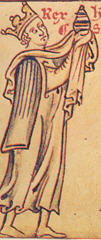
An upcoming article will shed light on the large collection of gold and jewels held by a medieval English king.
"Secrecy, splendour and statecraft: the jewel accounts of King Henry III of England, 1216–72" was written by Benjamin Wild of King's College London. He analyzes a set of accounts which describe the gifts that were given and received by Henry III, the purchase of gems and specie, as well as expensive fabrics, such as cloth of gold.
In an interview with Medievalists.net, Dr. Wild said, "The jewel accounts are not merely a descriptive record of royal purchases. They also describe the flow of gifts in and out of the wardrobe. Gift-giving was ubiquitous in medieval society, helping to make, maintain and mend political and social relationships. The information within the jewel accounts is therefore very useful because it helps us to see who was doing the giving and receiving in and around Henry's court."
These records are part of the larger wardrobe accounts, which Dr.Wild explains, "preserve a record of the English king's personal expenditure. This includes everything from victuals, wine and spices, to clothes, building work and suits of armour."
The Jewel accounts are available for the reigns of Henry III up to Edward III. No other medieval state has similar kinds of surviving records.
The research reveals that the English king owned a surprisingly large amount of these treasures. The first surviving record, from 123, reveals that he had over 2000 items, including 173 rings, 103 gold brooches, 219 cloths of gold and hundreds of gold coins from as far away as North Africa.
By 1272, the collection had grown to over 2500 items, including 1168 rings. The Jewel Accounts also occasionally reveal more indepth information about some of his treasures. One record mentions a great bowl of silver, weighing 117 troy ounces, which Henry used to wash the feet of paupers during the Maundy celebrations. Another entry describes two miniature silver-gilt horses that had been given to King Henry by certain unnamed Jews.
Benjamin Wild's article goes on to reveal information about how the English King gave gifts of these treasures to his family, followers and to other European royalty, and how some of these items were sold off or got stolen.
"I think the most interesting discovery is that the jewel accounts show how Henry III increased the levels of his gift-giving at times of great political moment," said Dr.Wild. "According to the jewel accounts, the king distributed considerably more gifts (belts, cups, rings and brooches being the most common) during three crucial key periods: (1) 1234 (at the start of his so-called 'personal rule'); (2) between 1259 and 1260, when he was in France to ratify the controversial Treaty of Paris (by which Henry and his heirs renounced their claims to Normandy, Anjou and Poitou, in return for Gascony, which was to be held from the king of France); (3) after August 1265, when King Henry was able to revive his authority after the brutal murder of his brother-in-law and former jailer, Simon de Montfort. Henry III is often thought to have distributed gifts and patronage in a rather profiligate manner. The evidence of the jewel accounts suggests Henry was actually much more shrewd."
The article will appear in an upcoming issue of Historical Research. Dr. Wild has recently completed his PhD dissertation and is now preparing to publish several volumes of the wardrobe accounts for the reigns of Henry II and his son Edward I for the Pipe Roll Society. He has also started work on a book, prospectively titled King Henry III and the Power of Aesthetics, which he says "will shed new light of Henry III's use of art, ceremony and architecture. The wardrobe accounts, which provide detailed information about the English king's personal expenditure, will be a major source for this study."